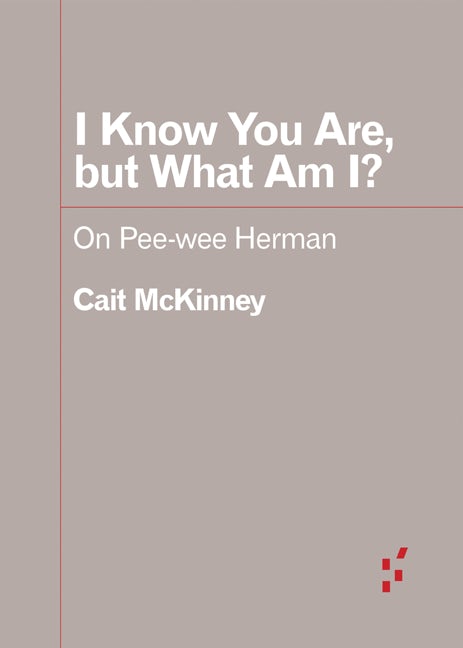 I KNOW YOU ARE, BUT WHAT AM I?
I KNOW YOU ARE, BUT WHAT AM I?
On Pee-wee Herman
by Cait McKinney
University of Minnesota Press
92 pages, $10.
IN A SHARP and succinct monograph, Vancouver-based author Cait McKinney delves into the late Paul Reubens’ most important achievement, that of creating and sustaining the show starring his alter ego, Pee-wee Herman. The book’s main title, I Know You Are, But What Am I?, invokes one of Pee-wee’s favorite catchphrases. The book serves two main purposes: it is an eloquent eulogy for Reubens and his importance for the generation that grew up watching his Emmy-winning show, and for young queer fans in particular; and it provides an overview of critical writing about Pee-wee and his body of work.
McKinney had a lot of material to work with. Over the span of five seasons (1986-91), Pee-wee’s Playhouse offered viewers entry into a world that was beautifully childlike and naïve while simultaneously full of sly parodies of gender stereotypes. As McKinney points out,
McKinney notes how distinctly queer this remarkable bit of performance art was. Pee-wee’s buddies were often musclebound stereotypes or femme gals in drag. Pee-wee himself was a kind of asexual man-boy, wearing makeup and dressing in a suit two sizes too small. McKinney recalls the episode in which Pee-wee gulps down a bowl of fruit salad, saying how much he loves it. “Then why don’t you marry it?” he is dared by a talking chair using one of his own lines against him. “Okay!” he exclaims, whereupon he marries his bowl of fruit salad on national TV.
The author also notes how countercultural Pee-wee’s Playhouse was in many ways. This was the decade when steroid-infused macho action stars saturated the culture, though they were already something of a throwback to times past. Pee-wee was about as far from Schwarzenegger, Stallone, and Bruce Willis as one could imagine. The show premiered in the same year of the Supreme Court’s infamous Bowers v. Hardwick decision (1986), which upheld the states’ right to criminalize sodomy. This was during the Reagan years, when we were told that old-fashioned values were back in vogue. Pee-wee parodied these yearnings for yesteryear, exposing them for the performative nonsense that they usually were. The show (and Pee-wee) was one of many jarring contradictions of the era, which saw Boy George and Bronski Beat soar in popularity even while an AIDS-fueled anti-gay backlash unfolded. There was resurgent conservatism and reactionary politics but also vital cultural resistance.
Next we enter into the distorted horror show that was Reubens’ 1991 arrest for public indecency in a Sarasota, Florida, adult theater. McKinney painfully recounts the details: the scandal led to Reubens retiring the Pee-wee character for years, even though the incident was rife with misperceptions. The cinema was not one that screened Disney films; on the contrary, it was a porn cinema where men often pleasured themselves or hooked up with other men, and it was the target of repeated police sting operations (obviously rooted in homophobia). As many noted in articles after Reubens’ death, this should barely have registered at all, let alone damaged Pee-wee’s reputation as severely as it did. But it played conveniently into the moral panic of the day.
McKinney does an admirable job of reframing much of the scandal and paying homage to the genius of Pee-wee Herman. The book celebrates that such a singular, queer, and transgressive character ever existed, and the author’s sadness at Reubens’ passing is palpable. It’s a fitting tribute, one that Reubens richly deserves.
Matthew Hays, co-editor of the Queer Film Classics book series, teaches film studies at Marianopolis College in Montreal.